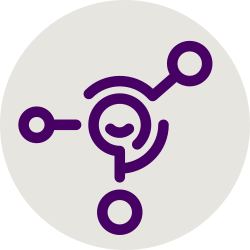I reformulated Gabriel Mays’ article Business questions worth asking to be a better match for Sustainable FOSS. From here the questionaire can be further improved and additional questions added.
 In this questionaire “sustainable” refers to:
In this questionaire “sustainable” refers to:
- Financially healthy to support most work people do.
- Community-based and inclusive to all its participants.
- Focused on the entire lifecycle of solutions that are built.
- Collaborative within larger FOSS-based ecosystems.
See an overview of terminology changes (click to expand)
Terminology changes:
- Use “client” instead of “customer”. Indicates broader audience, less business-like.
- Use “offering” instead of “proposition”. Less formal, less business-like.
- Use “solution” instead of “product”. More appropriate for FOSS, less business-like
- Avoid “sell”. We don’t do sales, but provide convincingly good solutions.
- Avoid “business”. When it refers to “offering”, use that. Otherwise use “sustainable business”.
- Avoid “market”. FOSS focuses on “audience”/“stakeholders”, “demands” and “needs” of people.
- Use “key abilities” instead of “core competencies”. Less formal. Favors inclusive collab to competition.
- Replace “[market] trends” with “needs”. Solutions should satisfy real needs in society.
- Use “efforts” instead of “investments”. Less business-like. FOSS projects are a collaborative effort.
- Use “assumptions” instead of “[market] bets”. Sustainable FOSS doesn’t “bet on the market”.
- Replace “winning” with “[achieving] sustainability”. Winning is a meaningless term in FOSS movement.
Other changes:
- Ordering of questions, to help put client’s needs first, front and center.
 Key questions
Key questions
1. Which pain of our client does our solution remove?
2. How do we quickly delight clients, convey the "wow" factor?
3. How do we reach our clients?
4. How do we deliver most value early and as often as possible?
 Providing value to clients
Providing value to clients
5. How does our solution make things easier or serve clients better?
6. How do we ensure clients using our solution are significantly
better off than before?
7. When clients use our solution, how do we want it to change them?
How do we convey that vision to get them to switch?
8. What value does this deliver to our clients?
9. Are we doing what’s right for the client? Always? No matter what?
10. Where do clients want to spend money? What encourages them
to keep doing so?
11. How do we understand what people think they want and translate
the value of our solution into their terms?
12. Are we building our offering around solution clients love to use?
13. Are we starting with technology or with client's needs?
We should start with the client and work back towards the tech,
because tech is just a tool to solve a client's problems.
14. How do we put focus on the innovation, not the solution?
 Strategic introspection & key abilities
Strategic introspection & key abilities
15. Projects positioned in the way things used to be and predicated on old
assumptions may not survive. What assumptions is our solution based on?
Are they still true? Will they continue to be?
16. There are vision problems, sustainable business model problems,
and execution problems. Which do we have?
17. FOSS projects succeed when they focus on what is truly unique to them.
What can we be uniquely good at?
18. Are we differentiated, or are we more like the low-barrier choice?
19. Do we have small objectives, or big ambitions? In other words,
are we chasing field mice or hunting antelope?
20. Are there any places we succeeded because a strong demain for our
solution allowed us to be strategically inept?
Find examples of similar projects that never had to do the hard work of
1) understanding what made them successful and
2) building a real sustainable model until it was too late.
21. What things about our [audience/clients] will never change?
Are we giving enough attention to those?
22. Assume it’s one year from now, and we failed at our goal. What went wrong?
23. What would my replacement do if I would hand over my tasks?
24. Culture is a microcosm of the community member's psychology.
How is our culture shaped by the collaborative?
25. Are we listening enough to the people on the front lines?
26. Are we putting enough importance on making the ‘important thing’ good?
27. Are we involved in too much loose talks (waving our arms)
and not enough true commitment (earning trust)?
28. For project/solution-related services: Are we maximizing our
addressable audience?
29. What fair advantage distinguishes us from unfair business competitors?
 Needs discovery
Needs discovery
30. How do we embrace the transition to [focus on needs] and adequately
[satisfy needs] for the long term?
31. What needs are we best positioned to satisfy?
32. How will we (financially) sustain ourselves in the future
(satisfy our own needs)?
33. What’s the future state of the world, and what changing needs will
people have because of it?
34. If applicable: How do we thrive in a post [past need relevancy] world?
35. Is our positioning realistic, or are we fighting gravity?
 Opportunities & adaptive strategy
Opportunities & adaptive strategy
36. From our current state what would a "delightful" solution look like?
How would we start over? What is the client’s fundamental problem,
and how do we solve it this way?
37. What big assumptions are we making?
38. What would (holistic) sustainability look like if it were easy achievable?
39. How can we apply commodity services as building blocks for
higher-level services?
40. Complex systems can’t be designed. They can only evolve. What synergies
can we ceate around our project, community and ecosystem and all
the people involved with them?
41. Where should we tinker with objectives vs. tinkering with alternatives?
Sometimes related: It’s often easier to change the our collaborative
framework than to change our fundamental nature as a sustainable
project / business.
42. Are our efforts aligned with our opportunities?
43. If success is achieved by going to extremes, should we even do this?
How would a sustainable project or business do this and stay
true to its values?
 Experience & differentiation
Experience & differentiation
44. Are we fully dedicated to removing friction for our clients?
45. Are we thinking about the full lifecycle of the social experience
(from inception to end-of-life) our solution provides?
Do we objectify people as "users" and more narrowly consider only
the UX/UI? Features don’t create differentiation, experiences do.
46. Does every solution we have complement the rest of our solutions and
make them more attractive?
47. How can we pull modular components together into solutions around
our client's problems and needs?
 Alignment
Alignment
48. Are incentives (expectations/motivations) across the project, community,
ecosystem and solutions well aligned?
49. What outcomes are we incentivizing? Collaboration is about balancing
a series of incentives where people are motivated and encouraged to do
the right thing because it’s in their best interest, corresponds to their
passions and the values they hold dear.
50. Do we have clear tasks and goals, clearly communicated,
with clear and frequent measurement?
51. Strategy is about decisions and trade-offs: Are we moving one step in 20
directions or 20 steps in one direction? Favor focus over compromise.
Strategy is also about what you don’t do.
 Efficiency
Efficiency
52. Long term sustainable FOSS depends on many aspects. Sustainability
is a holistic concept. What are the sustainability criteria of our project
and how do we measure them?
53. Where can we turn our efforts to best use to achieve
holistic sustainability?
54. How do we get 80% of what we want for 20% of the work?
55. Are we spending effort, time or money where it does not sufficiently
address our needs and those of our clients?
56. Over the long run, sustainability involves inherent efficiency.
How efficient are we relative to our peers? How do we make continuous
small improvements part of the process to become more efficient?
57. Do we celebrate progress, even if only small steps forward, as a habit?


 In this questionaire “sustainable” refers to:
In this questionaire “sustainable” refers to: Key questions
Key questions Providing value to clients
Providing value to clients Strategic introspection & key abilities
Strategic introspection & key abilities Needs discovery
Needs discovery Opportunities & adaptive strategy
Opportunities & adaptive strategy Experience & differentiation
Experience & differentiation Alignment
Alignment Efficiency
Efficiency